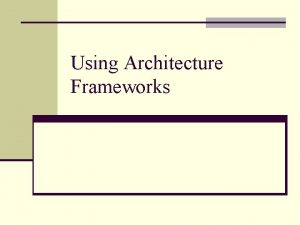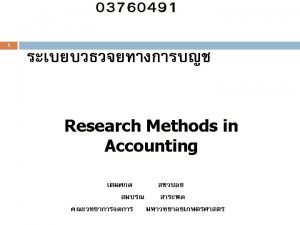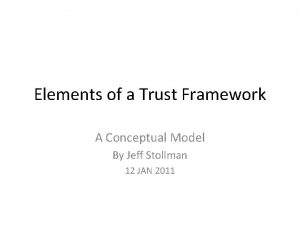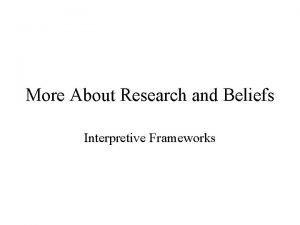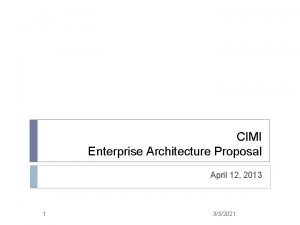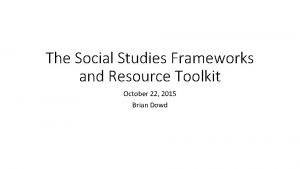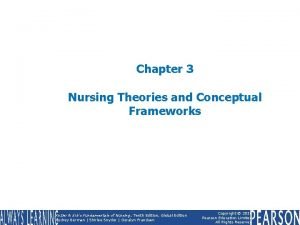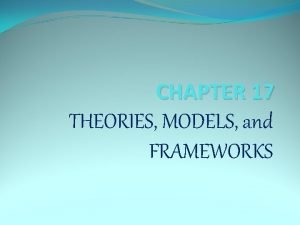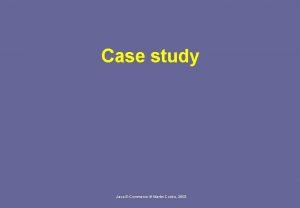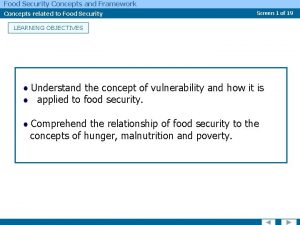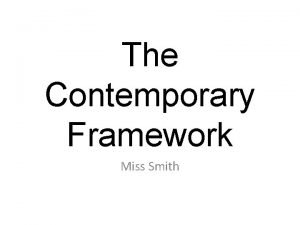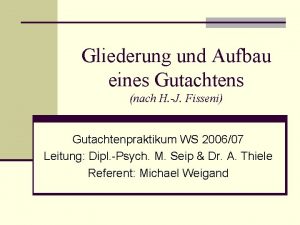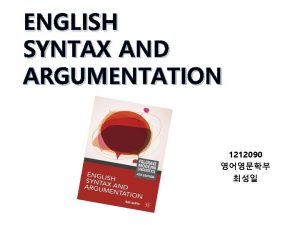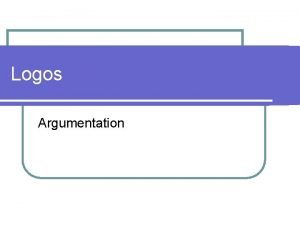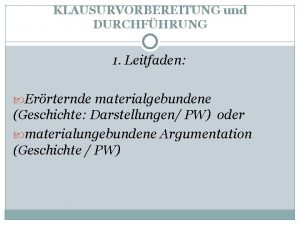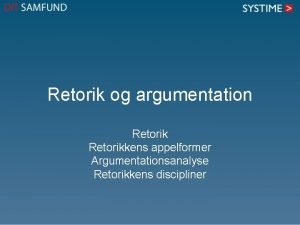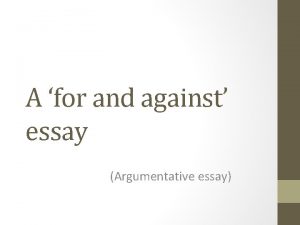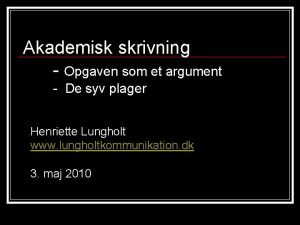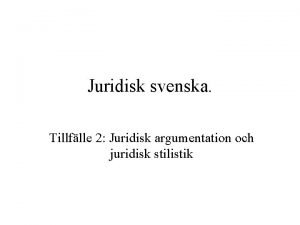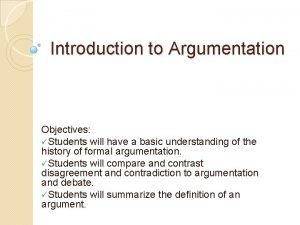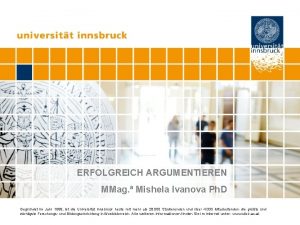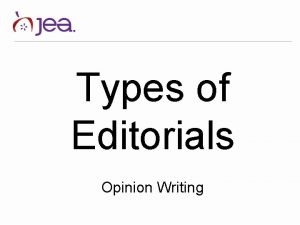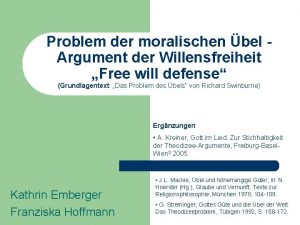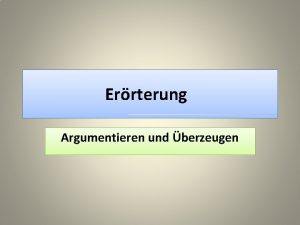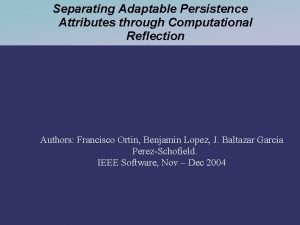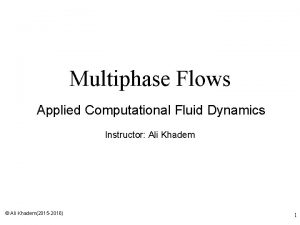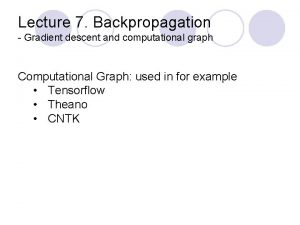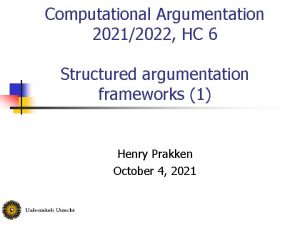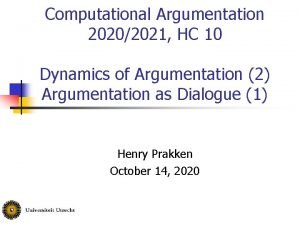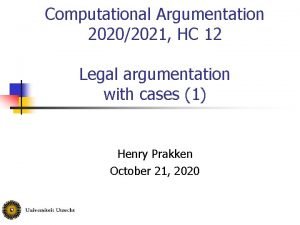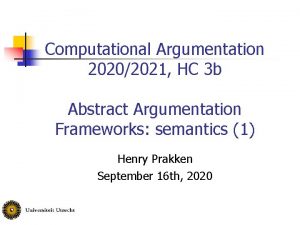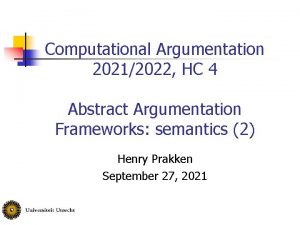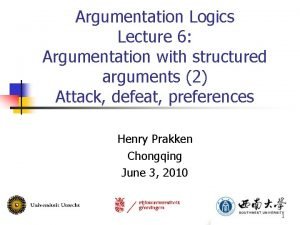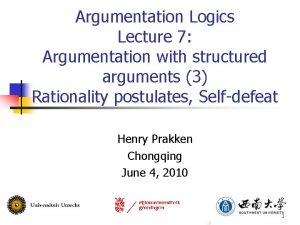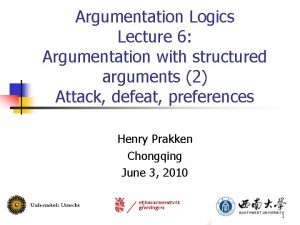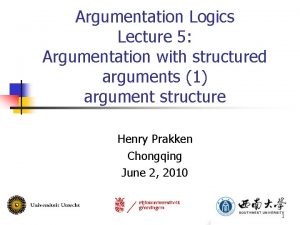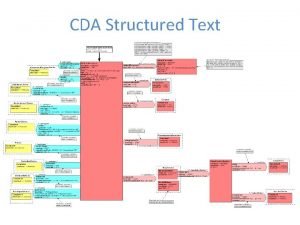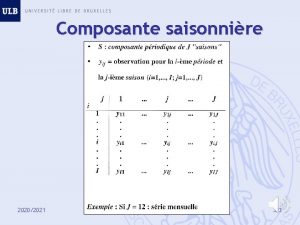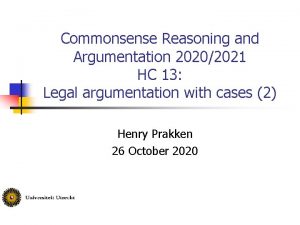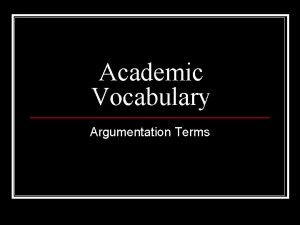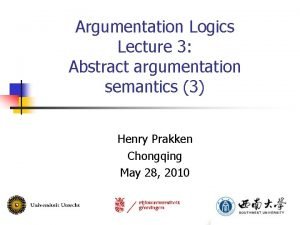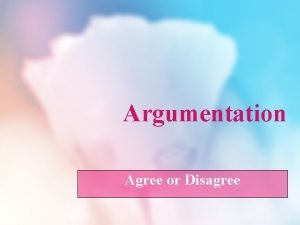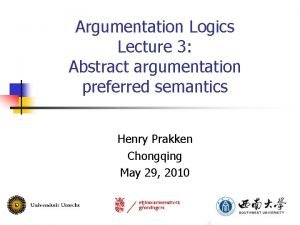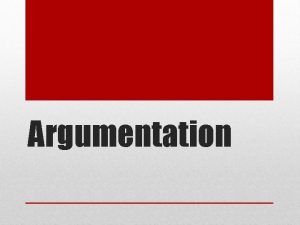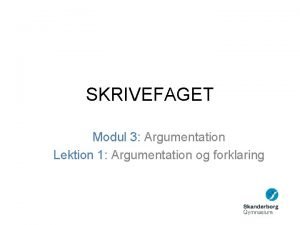Computational Argumentation 20202021 HC 7 Structured argumentation frameworks



















































- Slides: 51

Computational Argumentation 2020/2021, HC 7 Structured argumentation frameworks (2) Henry Prakken September 30, 2020

Overview n n n Ways to choose the rules Preferences Rationality postulates 2

Part 1: Choice of rules 3

ASPIC+ framework: overview Argument structure: n Directed acyclic graphs where n Nodes are wff of a logical language L n Links are applications of inference rules n n n Rs = Strict rules ( 1, . . . , n ); or Rd= Defeasible rules ( 1, . . . , n ) Reasoning starts from a knowledge base K L Defeat: attack on conclusion, premise or inference, + preferences Argument acceptability based on Dung (1995) 4

Domain-specific vs. inference general inference rules Flies n n n n d 1: Bird Flies s 1: Penguin Bird Penguin K Bird Penguin Rd = { , } Rs includes {S | S |-PL and S is finite} Bird Flies K Penguin Bird K Penguin K Bird Penguin Flies Bird Flies Penguin Bird 5

Deriving the strict rules from a monotonic logic n For any logic L with (monotonic) consequence notion |-L define S p Rs iff S is finite and S |-L p 6

Argument(ation) schemes: general form Douglas Walton Premise 1, …, Premise n Therefore (presumably), conclusion n But also critical questions John Pollock 7

Argument schemes in ASPIC n n Argument schemes are defeasible inference rules Critical questions are pointers to counterarguments n n n Some point to undermining attacks Some point to rebutting attacks Some point to undercutting attacks 8

Perception P is observed Therefore (presumably), P n Critical questions: n n n Are the observer’s senses OK? Are the circumstances such that reliable observation of P is impossible? …

Reasoning with default generalisations P If P then normally/usually/typically Q So (presumably), Q - What experts say is usually true People with political ambitions are usually not objective about security People with names typical from country C usually have nationality C People who flee from a crime scene when the police arrives are normally involved in the crime - Chinese people usually don’t like coffee n n But defaults can have exceptions And there can be conflicting defaults 10

How are generalisations justified? n n n Scientific research (induction) Very reliable Experts Commonsense Individual opinions Prejudice? Very unreliable 11

Inducing generalisations Almost all observed P’s were Q’s Therefore (presumably), If P then usually Q A ballpoint shot with this type of bow will usually cause this type of eye injury In 16 of 17 tests the ballpoint shot with this bow caused this type of eye injury n Critical questions: n n Is the size of the sample large enough? was the sample selection biased? 12

Expert testimony E is expert on D E says that P P is within D Therefore (presumably), P is the case n Critical questions: n n n Is E biased? Is P consistent with what other experts say? Is P consistent with known evidence? 13

Supporting and using generalisations Defeasible modus ponens V’s injury was caused by a fall This type of eye injury is usually caused by a fall V has this type of injury Expert testimony scheme E says that his type of injury is usually caused by a fall E is an expert on this type of injury

Witness testimony W says P W was in the position to observe P Therefore (presumably), P n Critical questions: n n n Is W sincere? Does W’s memory function properly? Did W’s senses function properly? P is usually of the form “I remember that I observed that. . . ” 15

Memory P is recalled Therefore (presumably), P n Critical questions: n n Is the memory contaminated with other information? …

Temporal persistence (Forward) P is true at T 1 and T 2 > T 1 Therefore (presumably), P is still true at T 2 n Critical questions: n n Was P known to be false between T 1 and T 2? … 17

Temporal persistence (Backward) P is true at T 1 and T 2 < T 1 Therefore (presumably), P was already true at T 2 n Critical questions: n n Was P known to be false between T 1 and T 2? … 18

X murdered Y d. m. p. Y murdered in house at 4: 45 V murdered in L at T & S was in L at T S murdered V X in 4: 45{X in 4: 30} X in 4: 45 accrual X in 4: 45{X in 5: 00} backw temp pers forw temp pers X left 5: 00 X in 4: 30 accrual X in 4: 30{W 1} testimony W 1: “X in 4: 30” X in 4: 30{W 2} testimony W 2: “X in 4: 30” W 3: “X left 5: 00” 19

Arguments from consequences Action A causes G, G is good (bad) Therefore (presumably), A should (not) be done n Critical questions: n n n Does A also have bad (good) consequences? Are there other ways to bring about G? . . . 20

Example (arguments pro and con an action) We should lower taxes Lower taxes increase productivity Increased productivity is good We should not lower taxes Lower taxes increase inequality Increased inequality is bad 21

Example (arguments pro alternative actions) We should lower taxes Lower taxes increase productivity Increased productivity is good We should invest in public infrastructure Investing in public infrastructure increases productivity Increased productivity is good 22

Refinement: promoting or demoting legal/societal values Action A causes G, G promotes (demotes) legal/societal value V Therefore (presumably), A should (not) be done n Critical questions: n n n Are there other ways to cause G? Does A also cause something else that promotes or demotes other values? . . . 23

Example (arguments pro and con an action) We should save DNA of all citizens Saving DNA of all citizens leads to solving more crimes Solving more crimes promotes security We should not save DNA of all citizens Saving DNA of all citizens makes more private data publicly accessible Making more private data publicly available demotes privacy 24

Example (arguments pro alternative actions) We should save DNA of all citizens Saving DNA of all citizens leads to solving more crimes Solving more crimes promotes security We should have more police Having more police leads to solving more crimes Solving more crimes promotes security 25

Argument schemes about action (generalised) Action A results in C 1 … Action A results in Cn We should achieve C 1 … We should achieve Cn Therefore, We should do A Action A results in C 1 … Action A results in Cn We should avoid C 1 … We should avoid Cn Therefore, We should not do A

Part 2: Preferences 27

Argument preference n n n In general its origin is undefined General constraint: A <a B if B is strict-andfirm and A is defeasible or plausible. Could otherwise be defined in terms of partial preorders (on Rd) and ’ (on Kp) n Origins of and ’: domain-specific! 28

Two example argument orderings (Informal: Kp = , no strict-and-firm arguments) n Weakest link ordering: n n Compares all defeasible rules of each argument Last-link ordering: n Compares the last defeasible rules of each argument 29

Example R d: n d 1: p q n d 2: p r n d 3: s t Rs: q, r ¬t K: n ¬t t d 3 s r q d 1 d 2 p p, s 30

Comparing ordered sets (elitist ordering) n Ordering <s on sets in terms of an ordering (or ’) on their elements: n n n If S 2 = then not S 2 <s S 1 If S 1 ≠ and S 2 = then S 1 <s S 2 Else S 1 <s S 2 if there exists an s 1 S 1 such that for all s 2 S 2: s 1 < s 2 S 1 = {d 1, d 2} S 2 = {d 3, d 4} d 1 < d 3 d 1 < d 4 d 3 < d 2 S 1 <s S 2? S 2 <s S 1? 31

Comparing ordered sets (elitist ordering) n Ordering <s on sets in terms of an ordering (or ’) on their elements: n n n If S 2 = then not S 2 <s S 1 If S 1 ≠ and S 2 = then S 1 <s S 2 Else S 1 <s S 2 if there exists an s 1 S 1 such that for all s 2 S 2: s 1 < s 2 S 1 = {d 1, d 2} S 2 = {d 3, d 4} d 1 < d 3 d 1 < d 4 d 3 < d 2 S 1 <s S 2? Yes S 2 <s S 1? No 32

Comparing ordered sets (elitist ordering) n Ordering <s on sets in terms of an ordering (or ’) on their elements: n n n If S 2 = then not S 2 <s S 1 If S 1 ≠ and S 2 = then S 1 <s S 2 Else S 1 <s S 2 if there exists an s 1 S 1 such that for all s 2 S 2: s 1 < s 2 S 1 = {d 1, d 2} S 2 = {d 3, d 4} d 1 < d 3 d 1 ≈ d 4 d 3 < d 2 S 1 <s S 2? S 2 <s S 1? 33

Comparing ordered sets (elitist ordering) n Ordering <s on sets in terms of an ordering (or ’) on their elements: n n n If S 2 = then not S 2 <s S 1 If S 1 ≠ and S 2 = then S 1 <s S 2 Else S 1 <s S 2 if there exists an s 1 S 1 such that for all s 2 S 2: s 1 < s 2 S 1 = {d 1, d 2} S 2 = {d 3, d 4} d 1 < d 3 d 1 ≈ d 4 d 3 < d 2 S 1 <s S 2? No S 2 <s S 1? No 34

Weakest-link ordering (formal) n n A <a B if B is strict-and-firm and A is defeasible or plausible. Otherwise: A <a B iff n n n If both A and B are strict, then Premp(A) <s Premp(B) If both A and B are firm, then Def. Rules(A) <s Def. Rules(B); else Premp(A) <s Premp(B) and Def. Rules(A) <s Def. Rules(B) 35

Last-link ordering (formal) n n A <a B if B is strict-and-firm and A is defeasible or plausible. Otherwise: A <a B iff n n LDR(A) <s LDR(B); or A and B are strict and Premp(A) <s Premp(B) 36

Last link vs. weakest link (1) n n n r 1: Born in Scotland Scottish r 2: Scottish Likes Whisky r 3: Fitness Lover ¬Likes Whisky Kn: Born in Scotland, Fitness Lover r 1 < r 2, r 1 < r 3, r 2 ≈ r 3 Likes Whisky r 2 Scottish Likes Whisky r 3 Fitness lover r 1 Born in Scotland 37

Weakest link n n n r 1: Born in Scotland Scottish r 2: Scottish Likes Whisky r 3: Fitness Lover ¬Likes Whisky Kn: Born in Scotland, Fitness Lover r 1 < r 2, r 1 < r 3, r 2 ≈ r 3 Likes Whisky r 2 Scottish Likes Whisky r 3 Fitness lover r 1 Born in Scotland 38

Last link n n n r 1: Born in Scotland Scottish r 2: Scottish Likes Whisky r 3: Fitness Lover ¬Likes Whisky Kn: Born in Scotland, Fitness Lover r 1 < r 2, r 1 < r 3, r 2 ≈ r 3 Likes Whisky r 2 Scottish Likes Whisky r 3 Fitness lover r 1 Born in Scotland 39

Last link vs. weakest link (2) n n n r 1: Snores Misbehaves r 2: Misbehaves May be removed r 3: Professor ¬May be removed Kn: Snores, Professor r 1 < r 2, r 1 < r 3, r 2 ≈ r 3 May be removed r 2 Misbehaves May be removed r 3 Professor r 1 Snores 40

Part 3: Rationality postulates 41

Consistency in ASPIC+ (with symmetric negation) For any S L n S is directly consistent iff S does not contain two formulas and – The strict closure Cl(S) of S is S + everything derivable from S with only Rs. n n S is indirectly consistent iff Cl(S) is n directly consistent. n Parametrised by choice of strict rules 42

Rationality postulates (Caminada & Amgoud 2007) Let E be any Dung-extension and n n Conc(E) = { | = Conc(A) for some A E } A (c-)SAF satisfies n n n subargument closure iff B E whenever A E and B Sub(A) direct consistency iff Conc(E) is directly consistent strict closure iff Cl(Conc(E)) = Conc(E) indirect consistency iff Conc(E) is indirectly consistent

Violation of direct and indirect consistency in ASPIC+ n n n s 1: r ¬q Kn = ; Kp = {q, r} B 2 r <’ q A 1 B 2 q > A 1 q B 1 s 1 r B 1 44

Violation of direct and indirect consistency in ASPIC+ n n Constraint on a: If A = B then A ‘≈’ a B s 1: r ¬q s 2: q ¬r Kn = ; Kp = {q, r} r <’ q A 2 r s 2 q > A 2 B 2 A 1 B 1 q s 1 r 45

Trans- and contraposition n Transposition: n n If S p Rs then S/{s} U {–p} –s Rs Contraposition: n If S |- p and s S then S/{s} U {– p} |- –s

Rationality postulates for ASPIC+ (whether for SAFs or c-SAFs) n n Strict and subargument closure always satisfied Direct and indirect consistency: n without preferences satisfied if n n n and Kn is indirectly consistent (c-)SAF is well-defined with preferences satisfied if in addition <a is ‘reasonable’ n n Rs closed under transposition or AS closed under contraposition; If A is plausible or defeasible and B is strict-and-firm then A < B If A = B then A and B have the same ‘strength’ (Complicated condition) Weakest- and last link ordering are reasonable 47

Subtleties concerning rebuttals (1) n n d 1: Ring Married d 2: Party animal Bachelor d 2 < d 1 s 1: Bachelor ¬Married Kn: Ring, Party animal Married > Married d 1 Ring Bachelor d 2 Party animal 48

Subtleties concerning rebuttals (2) n n n d 1: Ring Married d 2: Party animal Bachelor d 2 < d 1 s 1: Bachelor ¬Married s 2: Married ¬Bachelor Kn: Ring, Party animal Bachelor Married > Married d 1 Ring Bachelor d 2 Party animal 49

Subtleties concerning rebuttals (3) Rd = { , } Rs = {S | S |-PL and S is finite} Kn: n d 1: Ring Married n d 2: Party animal Bachelor n n 1: Bachelor ¬Married n Ring, Party animal 50

Next time n n n Alternative attack relations ASPIC+ with generalised negation Relation with other work
 Dokumen 1 ktsp sma tahun 20202021
Dokumen 1 ktsp sma tahun 20202021 Structured analysis and design
Structured analysis and design Disadvantages of unstructured interviews
Disadvantages of unstructured interviews Knowledge frameworks
Knowledge frameworks Software architecture frameworks
Software architecture frameworks List of theoretical frameworks
List of theoretical frameworks Php frameworks
Php frameworks Why i hate frameworks
Why i hate frameworks Describe trust frameworks.
Describe trust frameworks. Parcc model content frameworks
Parcc model content frameworks Beneficence
Beneficence Interpretative framework
Interpretative framework Enterprise architecture proposal
Enterprise architecture proposal Arnoldo hax
Arnoldo hax Net frameworks 4
Net frameworks 4 Social studies toolkit
Social studies toolkit Actor frameworks
Actor frameworks The living tree of nursing theories
The living tree of nursing theories Conative message strategy
Conative message strategy Regional construction frameworks
Regional construction frameworks Nursing informatics theories, models and frameworks
Nursing informatics theories, models and frameworks Writing frameworks examples
Writing frameworks examples Local development framework
Local development framework A level english language frameworks
A level english language frameworks Java ecommerce frameworks
Java ecommerce frameworks Interpretive frameworks
Interpretive frameworks Enterprise agile frameworks
Enterprise agile frameworks Food security concepts and frameworks
Food security concepts and frameworks Contemporary framework art
Contemporary framework art Dialektische erörterung aufbau
Dialektische erörterung aufbau Aufbau eines gutachtens
Aufbau eines gutachtens English syntax and argumentation 연습문제 답
English syntax and argumentation 연습문제 답 Logos argumentation
Logos argumentation Appeasement politik
Appeasement politik Hvad er argumentationsanalyse
Hvad er argumentationsanalyse For and against essay
For and against essay Akademisk skrivning
Akademisk skrivning Juridisk argumentation
Juridisk argumentation Types of deductive arguments
Types of deductive arguments Argumentation
Argumentation Linking words for arguments
Linking words for arguments Tierversuche argumentation
Tierversuche argumentation Introduction to argumentation
Introduction to argumentation Mishela ivanova
Mishela ivanova 4 types of editorial writing
4 types of editorial writing Argumentation
Argumentation Argumentation
Argumentation Computational chemistry branches
Computational chemistry branches Computational reflection
Computational reflection Computational methods in plasma physics
Computational methods in plasma physics Computational fluid dynamics
Computational fluid dynamics Computational graph backpropagation
Computational graph backpropagation




